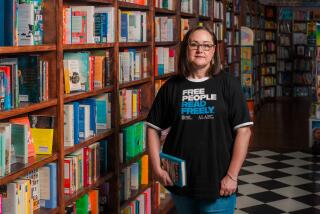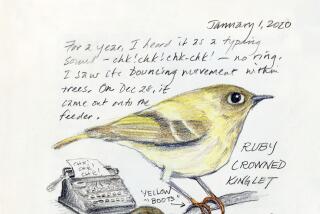Epic, simple
Don’t you just hate people who wake up cheerful? Give me a Grumpy Birdanytime:
When Bird woke up, he was grumpy.
He was too grumpy to eat.
He was too grumpy to play.
In fact, he was too grumpy to fly.
“Looks like I’m walking today,” said Bird.
“Grumpy Bird” (Scholastic: $12.99, ages 3-6) is the creation of Jeremy Tankard, for my money the most thrilling picture-book artist to arrive on the children’s book scene in recent years. The author and illustrator -- “authorstrator,” one young fan called him -- can make people of all ages laugh out loud.
His first book, “Grumpy Bird” (2007) introduced Bird, whose one-eyed squint at the irritating morning world made him an instant hero to anyone with a cranky toddler or a morning coffee jones. In the just-published sequel, “Boo Hoo Bird” (Scholastic: $14.99, ages 3-6), Bird gets a bonk on the head and develops the situation into the proportions of opera while taking all the consoling he can get. In between these two books, there was last year’s “Me Hungry” (Candlewick: $15.99, ages 3-6), about a caveboy’s epic, life-changing search for a bite to eat.
Like Mo Willems (see the “Knuffle Bunny” books), Tankard takes the worldview of the toddler seriously while appreciating its humor. He has distilled his insight into the toddler mind into dramas that are the pint-size equivalent of Shakespeare. A grumpy toddler, like Grumpy Bird, who is determined to fully experience her crankiness can wreak havoc on an entire household (her kingdom). A child with a boo-boo, like Boo Hoo Bird, can exhaust every possible form of comfort and bring the world around him to a halt before deciding it’s possible to let life go on. A resourceful child, like Edwin the caveboy, creates a new world every day.
Tankard uses repetition, one of the most reliable tricks in telling stories for small children, to great effect. In the Bird books, his animal friends respond one after another to Bird’s problem, each time with a small twist. When Bird gets bonked on the head during a game of catch, he starts to cry. “Here,” says Raccoon, “I’ll kiss it better.” But Bird keeps crying: “It still hurts.” So Raccoon says, “Let’s see if Rabbit can help.” Rabbit tries a hug, Beaver tries a cookie, and so on, as the situation becomes more desperate with each failure.
In reply to another suggestion -- “How about a game of hide-and-seek?” -- Bird wails: “You want me to hide? I CAN HARDLY WALK!” The animals finally see it’s hopeless, and they’re all weeping when Bird announces: “I think I’m OK now.” Of course, his friends can’t hear him, so he has to shout: “I said I’M ALL BETTER NOW!” The last page of “Boo Hoo Bird” shows the animals back at their ballgame when -- bonk! -- it happens again. Great use of repetition, and talk about a cliffhanger!
The resolution to all problems lies in the coziness of friendship. Grumpy Bird’s friends can jolly him out of a mood, and Edwin the caveboy finally satisfies his hunger with the help of a new pal.
I’m a word person, so I first appreciate the story in a book. But Tankard thinks of himself as a novice in the story department and speaks much more easily about the art. I spoke to him by phone at his home in Toronto, where he and his wife have just welcomed a second child:
Jeremy Tankard: Theo was born last Saturday [May 16]. My daughter Hermione is 7 1/2. It’s a big spread, quite nice for us, but I feel sorry for Theo. He’s going to have two mothers: Little Mom and Big Mom. Hermione’s quite excited about having a sibling. I don’t have a sibling book in the works, but my stories seem to keep coming back to friendships, which is not so unlike having a sibling. It’s all about building relationships.
Sonja Bolle: Although the character’s name is simply Bird -- and he’s Boo Hoo Bird in the new book -- do readers think of him as Grumpy Bird?
JT: His grumpiness seems to have captured readers’ imagination. I’ve given presentations and had teens say, “Grumpy Bird rules, man!” I’ll ask, “How on Earth do you know Grumpy Bird?” And they’ll say: “I saw it in a bookstore: It’s awesome!”
I’ve been shocked -- and, frankly, horrified -- by the number of adults who say Grumpy Bird is them in the morning. Or someone they know. In bookstores, they’ll say to me: “You should meet our manager, it’s him!”
SB: Is Grumpy Bird based on anyone in your life?
JT: I’d probably be in trouble if I answered that honestly.
SB: How did you get into children’s books?
JT: I had been illustrating for many years, but I always stayed away from children’s books -- I thought it was too much work for too little pay. But I had wanted to do it since I was about 4, when I first thought, “Someone has to write these things, why not me?” When my daughter Hermione was born, I went back to those roots. I sent out some of my illustration work, and Scholastic was one of the publishers that responded.
I got an editor out of it, someone who was willing to work with me through the process of learning to write. It was an amazing resource for someone who was not a writer. I took writing classes and took them very seriously. I would spend weeks and months trying to hatch out stories. They were all pretty dreadful.
Then when Hermione was about 3 1/2 -- I’d been at it for a couple of years -- she sat beside me on the couch one day. I always have a sketchbook with me, and she’s always asking me to draw things -- for a while there, I got really good at drawing lawn mowers -- and she said: “Daddy, draw grumpy things.” So I drew a grumpy bear, and a grumpy lion, a grumpy snake, a grumpy clock -- of all things! -- and then a bird.
I never drew animals, certainly not birds, and they have those stick-like feet, so I thought: “I’ll draw shoes.” He looked so grumpy! Hermione started giggling, and so did I, and I don’t often laugh when I’m drawing. My wife came down to see what we were laughing about.
I thought, here’s a really stupid idea: a bird who’s so grumpy he can’t fly. It took very little time to hash out the story, and I made up a dummy with some doodles.
I had a meeting with my editor, and I almost didn’t show it to her because I had spent so little time on it. In fact, I didn’t show it at first; I didn’t want to mess up my opportunity with a stupid idea. She politely read everything, then she asked: What else have you got? I very hesitantly pulled out “Grumpy Bird,” and she said. This is priceless! If you’re willing to work on this for however long it takes, I’ll work with you.
My other ideas were quite earnest. A lot were fantasy-based. In writing classes, people trying to do picture books often gravitate to fantasy, because they are influenced by Maurice Sendak. One editor told me: “Don’t do fantasy, you’re up against ‘Where the Wild Things Are.’ If you can’t do that, don’t do it at all.”
SB: How did you come to have two publishers?
JT: After “Grumpy Bird,” I told my agent I had another silly idea for a book about a hungry caveboy. All I had was the words “Me hungry.” “Great idea!” said the agent. She put it up for auction, and Candlewick bought it.
I consider myself very lucky to have these two publishers. I learned so much from my editor at Scholastic, who was willing to coach me in writing. Candlewick taught me something different altogether. In working on “Me Hungry!,” the editor and art director pushed me harder than I was ever pushed. After 10 years of developing an illustration style that culminated in “Grumpy Bird,” I had to learn to draw all over again.
What I thought of as my “signature style” was a layered look, dense with collage and colors. I do my characters with brush and ink, then with Photoshop you can add many layers; it creates a rich, dense illustration.
“Me Hungry!” was such a simple story, about a caveboy who’s looking for something to eat. I started with that layered background, but it didn’t suit the story: If the caveboy lived in this rich a world, he’d find a million things to eat.
So we started stripping things out, layers and layers of background, until all we had left was the rocks and the line of the horizon. Then we even stripped the horizon out. What we wanted was to give the story epic scope. This is a boy on a quest: He’s hungry. It’s primal. It’s important. It’s still kind of a silly story, but we wanted to give it an epic feel. With the horizon in the picture, he seemed close, but once we took out the horizon, he was out in a big world.
Originally I had prehistoric-looking plants, ferns and things; now, when he comes across the tree, it’s the first organic thing he sees -- except the animals, of course. Then he finds the apple! That really stands out, red is such a primal color. Edwin was originally wearing red sneakers, like Grumpy Bird, but I had to change them to orange. On school visits I usually ask kids, “What’s the most important color in this book?” And when I give them the hint that there’s not much of it, someone will usually come up with “red.”
“Me Hungry!” was a sad project to finish, because I learned so much doing it. On “Grumpy Bird” I had a massive learning curve, too, but that was about learning storytelling. “Me Hungry!” was a lesson in art. I couldn’t rely on tricks. Every single detail was considered; it was all so exposed.
I learned my strengths, and they were not what I thought they were. I discovered I have an ability to draw characters. Edwin in “Me Hungry!” is so much more animated than the animals in “Grumpy Bird.” He’s an actor. The end result is that “Me Hungry!” still has the heart and soul of “Grumpy Bird,” but now I feel I could do “Grumpy Bird” and take out all that rich background, and the characters could act out the story just as effectively. I learned I have other ways to tell a story in pictures.
SB: What kind of a reader are you?
JT: The irony was that [as a kid] I was not a big reader at all. There were a million things I’d rather do than read a book. I still love being read to, but it wasn’t until I was 30 or 31 that I started to enjoy reading. [He’s 36 now.]
Now I read a lot of YA, I’m about to start the “Gregor the Overlander” series by Suzanne Collins, and I’ve been reading “The Lord of Rings” for a long time.
SB: What do you read with your daughter?
JT: I’m currently reading “Julia Gillian” [by Alison McGhee] with Hermione, and I’m looking forward with Theo to reading picture books again. My favorite illustrators: Chris Raschka, William Bee -- his book, “And the Train Goes,” is really weird; he’s got a very British sense of humor. Hermione is a big fan of “Sardine in Outer Space,” this French comic book by Emmanuel Guibert and Joann Sfar. I don’t get all the stories, but Hermione loves them. She laughs aloud at stuff I shake my head at.
SB: Was your daughter named for Hermione in the “Harry Potter” series?
JT: Hermione was named only partly for “Harry Potter.” I had never heard the name before “Harry Potter.” Of course, Hermione Granger is a fantastic role model for any little girl: She’s brave, smart, stubborn, headstrong.
My wife is in English lit; there’s a Hermione in Shakespeare [“The Winter’s Tale”], and Hermione is the daughter of Helen of Troy.
SB: What are you working on now?
JT: Possibly an illustrated novel, maybe a chapter book taking advantage of my love of comic books. My editor at Scholastic did “The Invention of Hugo Cabret” with Brian Selznick, so she’s open to doing something unusual. I’ve got a story mostly written.
The great thing is that what I thought would be a hobby to supplement my work turns out to be a viable career.
Sonja Bolle’s Word Play column appears monthly at www.latimes.com/books.
More to Read
The biggest entertainment stories
Get our big stories about Hollywood, film, television, music, arts, culture and more right in your inbox as soon as they publish.
You may occasionally receive promotional content from the Los Angeles Times.










